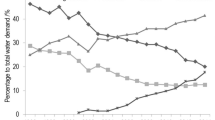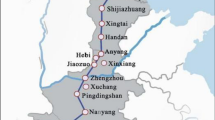Abstract
China has made great progress in the study of socio-economic water cycle. She has completed national water resources appraisement and medium to long-term water supply planning. She has been engaging in study on water-deficient regions in North China and Northwest China for about half a century. For solving water shortage problem in northern China, she has put forward the famous South-to-North Water Transferring Projects, which has been set as one of the four biggest national projects in the Tenth Five-Year-Plan period although there are still debates. For promoting water use efficiency, China has been reforming her water management system, including water right system and water price system. There has already been a case of water right purchase. China has also done a lot of research on the interaction between human activity, water and ecosystem. For meeting the need of sustainability and coordinating water resources development and environmental protection, the study of ecological water requirement became very hot in recent years. There are three focuses of socio-economic water cycle study now in China: water transfer projects from the south to the north, water resources management and ecological water requirement.
Similar content being viewed by others
References
Barker R, Molden D, 2000. Global Water Shortages, Alternatives for Increasing Water Productivity, and Implications for China. Paper Submitted to Water Policy Forum Jointly Held by the Center for Chinese Agricultural Policy of Chinese Academy of Sciences, International Water Management Institution on 1 June in Beijing, China, 2000.
Brown, Lester, Brian Halweil, 1998. China’s water shortages could shake world food security.World Watch, 11 (2): 10–18.
Chen Lei, Yang Guangxin, 1998. Deepen the property right innovation for small-scale water conservancy engineering and speed up the development of agricultural water conservancy cause.China Agricultural Water Conservancy and Hydroelectricity, (6). (in Chinese)
Chen Xueren, Ji Renbao, 1994. Overview of Irrigation Management Transfer in China. Paper Presented at the International Conference on Irrigation Management Transfer, Wuhan, P.R.China, September 20–24, 1994. (in Chinese)
Chen Zhikai, 1996. Successful management, utilization and protection of limited water resources.Water Issue Forum, (2).
Crook F, Diao X, 2000. Water Pressure in China: Growth Strains Resources. Agricultural Outlook, Economic Research Service, USDA. January-February, 25–29.
Dong Zheren, 1999. Proceedings of Water-Saving Agricultural Technologic Issues in China. Beijing: China Water Conservancy and Hydro-electricity Press. (in Chinese)
Feng Shangyou, 2000. Introduction to the Sustainable Utilization and Management of Water Resources. Beijing: Science Press. (in Chinese)
Hong L, Li Y H, Deng Let al., 2000. Impact of Water Saving Irrigation Techniques in China: Analysis of Changes in Water Allocations and Crop Production in the Zhanghe Irrigation System and District, 1966 to 1998. International Water Management Institute Annual Report, 1999–2000. (in Chinese)
Huang Mingbin, Yang Xinmin, Li Yushan, 2001. Effect of apple base on regional water cycle Weibei upland of the Loess Plateau.Acta Geographica Sinica, 56 (1): 7–13. (in Chinese)
Hydrology Bureau, Ministry of Water Resources (HBMWR), 1987. Water Resources Appraisement of China. Beijing: China Water Conservancy and Hydroelectric Power Press. (in Chinese)
Institute of Water Conservancy and Hydroelectricity Science of China (IWCHSC), 1996. The Macro-Management Mode for Water Resources of the Northern Plains of China. Beijing: China Water Conservancy and Hydroelectricity Press. (in Chinese)
Institute of Water Conservancy and Hydroelectricity Science of China (IWCHSC), Institute of Geographic Sciences and Natural Resources Research, CAS, Institute of Hydrogeologic Engineering, Ministry of Land and Resources, 2000. Special Report for the National Key Science and Technology Projects of China’s Ninth Five-Year-Plan: Study on the Reasonable Collocation and Carrying Capacity of the Water Resources in Northwest China, December 2000. (in Chinese)
Int. Water Management Institute (IWMI), 2000. IWMI’s research achievements 1995–1999. http:/www.iwmi.org/
Jia Shaofeng, 1997. Water saving effect calculation for improving the effective utilization coefficient of canal system.Irrigation and Drainage, (2). (in Chinese)
Jia Shaofeng, Kang Deyong, 2000a. The impact of the increased price of water on the demand for water resources: take North China Plain as an example.Advances in Water Science, (1). (in Chinese)
Jia Shaofeng, Kang Deyong, 2000b. Core for Prediction and Management of Water Resources Demand: Effective Demand of Water Resources. Proceedings of the International Symposium for Guarantee and Sustainable Utilization of Water Resources in Big Cities in the Early 21st Century, Tianjin, 8–11. May. (in Chinese)
Jia Shaofeng, Zhang Shifeng, 2000. When will fresh water use of China reach the climax?Advances in Water Science, (4). (in Chinese)
Jia Shaofeng, 2001. The economic feasibility of the South-to-North Water Transfer Project must be thoroughly carried out.Science and Technology Review, (7). (in Chinese)
Jiang Wenlai, 1998. On the Value of Water Resources. Beijing: Science Press. (in Chinese)
Ke Lidan, 1996. Water market of North China after realizing the water demand management.Water Issue Forum, (3).
Li Diejuan, Zhang Shifa, Zhu Shilinet al., 2000. The water price prediction for the water supply risk and external water diversion for Taiyuan City.Advances in Water Science, 11 (1). (in Chinese)
Liu Changming, He Xiwu, 1996a. Study of China Water Issues. Beijing: Meteorological Press. (in Chinese)
Liu Changming, He Xiwu, 1996b. Policy and Strategy of China’s Water Issues in the 21st Century. Beijing: Science Press. (in Chinese)
Liu Changming, Ren Hongzun, 1995. Study on the Sustainable Development and Utilization of Water Resources of China. China’s Advanced Technology Center. (in Chinese)
Liu Erzhong, 2001. To clear up misunderstanding of an initial plan for the South-to-North Water Transfer Project.Science and Technology Review, (7). (in Chinese)
Liu Shanjian, 1997. Population, food and water.Water Issues Forum, (2).
Liu Wen, 1997. Issues and measures urgent to be solved on the reform of water price.China Water Resources, (1). (in Chinese)
Liu Yanhua, 2000. Appropriate Exploitation and Utilization of the Water Resources and the Ecoenvironmental Protection for the Qaidam Basin. Beijing: Science Press. (in Chinese)
Ministry of Water Resources (MWR), 1999. The Strategic Research Project Group for the Development of Water Conservancy in the Early 21st Century of the National Planning Committee, the Strategic Research for the Development of China’s Water Conservancy in the Early 21st Century. (in Chinese)
Nanjing Hydrology and Water Resources Research Institute (NHWRRI) of MWR, Department of Water Resources Research, Institute of Water Conservancy and Hydroelectricity Science of China, MWR, 1999. Water Demand and Supply of China. Beijing: China Water Conservancy and Hydroelectric Power Press. (in Chinese)
Pang Jinwu, 1998. Issues and policies in the implementation of the unified management of the water resources,Water Issues Forum, (4). (in Chinese)
Shen Dajun, Liang Ruiju, Wang Haoet al., 2000. Theory and Practice for Water Price. Beijing: Science Press. (in Chinese)
Shen Ganqing, 1999. Discussion on the water conservancy pattern of the eco-economic type of environment.Advances in Water Science, (3). (in Chinese)
Shen Zhenrong, Wang Lin, Yu Fulianget al., 1999. New Concept for Water Saving: Study and Application of Real Water Saving. Beijing: China Water Conservancy and Hydroelectric Power Press, (in Chinese)
Tang Qicheng, Qu Yaoguang, Zhou Yuchao, 1995. Hydrology and the utilization of water resources in China’s arid areas.Journal of Arid Land Resources and Environment, 9 (3): 107–112. (in Chinese)
Wang Chunyuan, Yang Yongjiang, 1999. Economics of Water Resources and Its Application. Beijing: China Water Conservancy and Hydroelectricity Press. (in Chinese)
Wang Guo, Jia Shaofeng, Yu Guiruiet al., 2001. New progress of research on water cycle in atmosphere in China.Journal of Geographical Sciences, 11 (4): 480–489.
Wang Jinxia, Huang Jikun, Scott Rozelle, 2000. The innovation and theoretical explanation for the property right system of the groundwater irrigation system: the demonstration study of the small-scaled water conservancy engineering.Economics Study.
World Water Council (WWC), 2000. World Water Vision 2025. Earthscan Publications Ltd.
Xia Jun, 1999. Management and Application Study of the Sustainable Water Resources of the Bosten Lake, the Water Conservancy and Electric University of Wuhan, the Water Conservancy Bureau of Bayinguol Mongolian Autonomous Prefecture in Xinjiang.
Xiang Qing, Huang Jikun, 2000. A study for evolvement of property rights of the groundwater irrigation system and adjustment of the vegetating industrial structure.Management World, (5): 163–168. (in Chinese)
Xu Xinyi, Wang Hao, Gan Hong, 1997. Theories and Methods for the Planning of Macro-Economic Water Resources of North China. Zhengzhou: Huanghe River Water Conservancy Press. (in Chinese)
Zhang Q, Zhang X, 1995. Water issues and sustainable social development in China.Water Development, 20 (3): 122–128.
Zhang Yue, 2000. Top ten challenges to be encountered for China water conservancy in the 21st century.China Water Resources, (6). (in Chinese)
Author information
Authors and Affiliations
Rights and permissions
About this article
Cite this article
Shao-feng, J., Guo, W., Shi-feng, Z. et al. Research progress of socio-economic water cycle in China. J. Geogr. Sci. 12, 114–120 (2002). https://doi.org/10.1007/BF02837435
Received:
Accepted:
Issue Date:
DOI: https://doi.org/10.1007/BF02837435




